Fishing Regulations
Largemouth bass is the most popular and most abundant sportfish
in the reservoir. White bass and striped bass also provide an excellent
fishery. Stripers provide excellent angling because of their growth
potential and strong fighting characteristics. An annual TPWD stocking
program maintains the fishery because striped bass do not successfully
reproduce in this reservoir. Crappie fishing is generally poor,
although occasionally good catches can be made, especially along
standing timber in the river. Angling for redbreast sunfish can
provide an excellent fishing experience for the family. Channel,
blue, and flathead catfish are present in good numbers. Smallmouth
bass are also present in small numbers. They tend to prefer rocky
habitat found in main lake areas.
Fishing Cover/Structure
Canyon Lake is dominated by steep rocky banks, isolated flooded
timber, and clear water typical of a highland reservoir. The water
becomes stained as one moves up the reservoir and into the river.
In most of the lake rock ledges, rock piles, steep drop-offs, flooded
timber, and a few marinas provide cover for game fish. The river
portion of the reservoir is dominated by flooded timber, rock ledges,
and laydowns. When the water level is high, largemouth bass anglers
should concentrate on the flooded terrestrial vegetation.
Tips & Tactics
Largemouth bass anglers are most successful on Canyon Lake during
the spring, fall, and winter months. Bass fishing in summer on this
highland reservoir can be difficult even for the most experienced
anglers. Topwater baits such as buzzbaits, Zara Spooks, and Pop-R's
are popular in the early morning and evening hours. On cloudy days
consistent topwater action can occur all day. Crankbaits are also
very popular fished along main-lake points, rocky shorelines, and
flooded timber. Popular soft plastic baits include worms, spider
grubs, grubs, and soft-jerkbaits. Try spinning gear and light line
(6-10 lb.) in main-lake clear water situations.
For white and striped bass in the summer and early fall, look for
schooling activity around main-lake points and humps. These fish
can be caught using topwater baits, jigging spoons, grubs, and rattletraps.
Popular techniques for striped bass are trolling with in-line spinners
and crankbaits and vertically jigging white bucktail jigs. Live
bait presentations for both striped and white bass are popular at
all times of the year. White bass spawning migrations occur from
February through April. During these months, white and striped bass
can be concentrated in the river portion of the reservoir. Anglers
catch white and striped bass at this time using small in-line spinners,
small jigs, jigging spoons, small crankbaits, and live bait presentations.
Catfish anglers can find channel, blue, and flathead catfish throughout
the reservoir. Channel catfish dominate the fishery. Stinkbait and
cutbait work well for channel and blue catfish, while live bait
is preferred for flathead catfish. The most consistent catches come
from the upper third of the reservoir. Trotlining is very popular
for flathead catfish. |
 |
 |
 |
 |
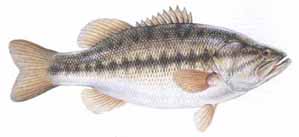 |
Illustration
© TPWD |
Largemouth Bass (Micropterus salmoides)
Other Names
Black Bass, Green Trout, Bigmouth Bass, Lineside Bass
Description
Largemouth bass grow 4 to 6 inches (10 to 15 cm) during their first
year, 8 to 12 inches (20 to 30 cm) in two years, 16 inches (40 cm)
in three years. They are usually green with dark blotches that form
a horizontal stripe along the middle of the fish on either side.
The underside ranges in color from light green to almost white.
They have a nearly divided dorsal fin with the anterior portion
containing nine spines and the posterior portion containing 12 to
13 soft rays. Their upper jaw reaches far beyond the rear margin
of the eye.
Life History
Except for humans, adult largemouth bass are the top predators
in the aquatic ecosystem. Fry feed primarily on zooplankton and
insect larvae. At about two inches in length they become active
predators. Adults feed almost exclusively on other fish and large
invertebrates such as crayfish. Larger fish prey upon smaller bass.
In Texas spawning begins in the spring when water temperatures
reach about 60°F. This could occur as early as February or as
late as May, depending one where one is in the state. Males build
the nests in two to eight feet of water. Largemouth bass prefer
to nest in quieter, more vegetated water than other black bass,
but will use any substrate besides soft mud, including submerged
logs. As in Guadalupe bass, once the female has laid eggs in the
nest (2,000 to 43,000) she is chased away by the male who then guards
the precious eggs. The young, called fry, hatch in five to ten days.
Fry remain in a group or "school" near the nest and under
the male's watch for several days after hatching. Their lifespan
is on average 16 years.
Immature largemouth bass may tend to congregate in schools, but
adults are usually solitary. Sometimes several bass will gather
in a very small area, but they do not interact. Largemouth bass
hide among plants, roots or limbs to strike their prey.
Habitat
Largemouth bass seek protective cover such as logs, rock ledges,
vegetation, and man-made structures. They prefer clear quiet water,
but will survive quite well in a variety of habitats.
Distribution
Largemouth bass were originally distributed throughout most of
what is now the United States east of the Rockies, including many
rivers and lakes in Texas, with limited populations in southeastern
Canada and northeastern Mexico. Because of its importance as a game
fish, the species has been introduced into many other areas worldwide,
including nearly all of Mexico and south into Central and South
America.
Other
Two subspecies of largemouth bass exist in Texas: the native Micropterus
salmoides salmoides and the Florida largemouth bass, Micropterus
salmoides floridanus, which has been introduced into many Texas
lakes. The largemouth bass is by far the most sought-after fish
in Texas. When anglers were asked to "name the fish you prefer
to catch in freshwater in Texas", they chose largemouth bass
three to one over striped bass, four to one over white bass, nearly
five to one over channel catfish, and nearly ten to one over flathead
catfish and white crappie. Because of the strong interest in largemouth
bass fishing, there are hundreds of bass angling clubs in Texas
devoted to fishing and conservation. Bass fishing adds greatly to
the Texas economy each year and largemouth bass are highly prized
for their value as food. Because of the species' popularity, it
has been introduced into many waters in which it did not originally
occur. As with nearly all aquatic species, pollution and drought
are the biggest threats to the largemouth bass population.
|
 |
 |
 |
 |
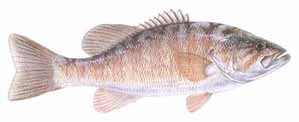 |
Illustration
© TPWD |
Smallmouth Bass (Micropterus dolomieu)
Other Names
Brown Bass, Brownie, Bronze Bass
Description
The smallmouth bass is generally green with dark vertical bands
rather than a horizontal band along the side. There are 13-15 soft
rays in the dorsal fin, and the upper jaw never extends beyond the
eye. Known maximum size in Texas exceeds 7.5 pounds. Micropterus
is Greek meaning "small fin" [see Guadalupe bass for further
explanation]. The species epithet dolomieu refers to the French
mineralogist M. Dolomieu.
Life History
In small streams a fish's activity may be limited to just one stream
pool or extend into several. Spawning occurs in the spring. When
water temperatures approach 60°F males move into spawning areas.
Nests are usually located near shore in lakes; downstream from boulders
or some other obstruction that offers protection against strong
current in streams. Mature females may contain 2000-15,000 golden
yellow eggs. Males may spawn with several females on a single nest.
On average each nest contains about 2,500 eggs, but nests may contain
as many as 10,000 eggs. Eggs hatch in about 10 days if water temperatures
are in the mid-50's (°F), but can hatch in 2-3 days if temperatures
are in the mid-70's (°F). Males guard the nest from the time
eggs are laid until fry begin to disperse, a period of up to a month.
As in other black bass, fry begin to feed on zooplankton, switching
to insect larvae and finally fish and crayfish as they grow.
Habitat
Smallmouth bass prefer large clear-water lakes (greater than 100
acres, more than 30 feet deep) and cool streams with clear water
and gravel substrate.
Distribution
Smallmouth bass originally ranged north into Minnesota and southern
Quebec, south to the Tennessee River in Alabama and west to eastern
Oklahoma and southwestern Arkansas. Today there are few states,
east or west of the Rocky Mountains, where populations have not
become established. Florida and Louisiana are apparently free of
smallmouth bass. In Texas the species has been stocked in numerous
areas, particularly streams of the Edwards Plateau.
|
 |
 |
 |
 |
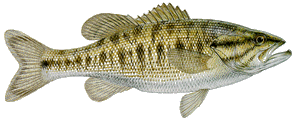 |
Illustration
© TPWD |
Guadalupe Bass (Micropterus treculii)
Other Names
Black Bass, Guadalupe Spotted Bass
Description
Micropterus is Greek, meaning "small fin" and is a rather
unfortunate misnomer arising from an injured type specimen that
made it appear that the posterior rays of the soft dorsal fin formed
a small separate fin. Treculi refers to Trecul, the French compatriot
of Vaillant and Bocourt. Trecul actually caught the specimen. The
Guadalupe bass is generally green in color and may be distinguished
from similar species found in Texas in that it doesn't have vertical
bars like smallmouth bass, its jaw doesn't extend beyond the eyes
as in largemouth bass, and coloration extends much lower on the
body than in spotted bass.
Life History
Guadalupe bass do not grow to large size because they are adapted
to small streams. However, a propensity for fast flowing water,
and their ability to utilize fast water to their advantage when
hooked, make them a desirable sport fish species. Their preference
for small streams enhances their allure to anglers because of the
natural setting where small streams are usually found. Specimens
in excess of 3.5 pounds have been landed.
Both males and females become sexually mature when they are one
year old. Guadalupe bass spawning begins as early as March and continues
through May and June. A secondary spawn is possible in late summer
or early fall. Like all other black bass, Guadalupe bass build gravel
nests for spawning, preferably in shallow water. As with spotted
bass and smallmouth bass, males tend to build nests in areas with
higher flow rates than largemouth bass. When a male has successfully
attracted a female to the nest she may lay 400 to over 9,000 eggs.
The female is then chased away and the male stands guard over the
incubating eggs. After hatching, fry feed on invertebrates and switch
to piscivory as they grow older. Very young fish and older adults
tend to include more invertebrates in their diet than do largemouth
bass. Juveniles and younger adults tend to include more fish in
their diets than do largemouth bass.
Habitat
Typically, Guadalupe bass are found in flowing water, whereas largemouth
bass are found in quiet water.
Distribution
The Guadalupe bass is found only in Texas and has been named the
official state fish. It is endemic to the northern and eastern Edwards
Plateau including headwaters of the San Antonio River, the Guadalupe
River above Gonzales, the Colorado River north of Austin, and portions
of the Brazos River drainage. Relatively small populations can also
be found outside of the Edwards Plateau, primarily in the lower
Colorado River. Introduced populations exist in the Nueces River
system.
Other
The Guadalupe bass, like other "black bass" including
largemouth, smallmouth, and spotted bass, is not a true bass at
all but a member of the sunfish family Centrarchidae.
|
 |
 |
 |
 |
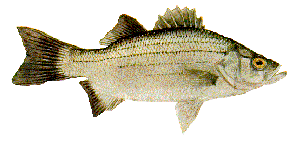 |
Illustration
© TPWD |
White Bass (Morone chrysops)
Other Names
Sand Bass, Barfish, Streaker, Silver Bass
Description
Morone is of unknown derivation. The species epithet chrysops is
Greek meaning "golden eye." As with other true basses,
the dorsal fin is clearly double, separated into spiny and soft-rayed
portions. White bass are silvery shading from dark-gray or black
on the back to white on the belly. Several incomplete lines or stripes
run horizontally on each side of the body. Adults resemble young
striped bass, and the two are often confused. However, striped bass
have two distinct tooth patches on the back of the tongue, and white
bass have one tooth patch. Striped bass have two sharp points on
each gill cover, as opposed to white bass which have one, and the
second spine on the anal fin is about half the length of the third
spine in striped bass, whereas it is about two-thirds the length
of the third spine in white bass.
Life History
White bass are active early spring spawners. Schools of males migrate
upstream to spawning areas as much as a month before females. There
is no nest preparation. Spawning occurs either near the surface,
or in midwater. Running water with a gravel or rock substrate is
preferred. Females rise to the surface and several males crowd around
as the eggs and sperm are released. Large females sometimes release
nearly a million small eggs during the spawning season. After release
eggs sink to the bottom and become attached to rocks, hatching in
2-3 days. Fry grow rapidly, feeding on small invertebrates. White
bass may grow eight or nine inches during the first year. Adults
are usually found in schools. Feeding occurs near the surface where
fish, crustaceans, and emerging insects are found in abundance.
Gizzard and threadfin shad are the preferred food items. White bass
more than four years of age are rare.
Distribution
White bass are native to the the central US west of the Appalachians,
including the Great Lakes, as well as river systems in the Ohio
and Mississippi river valleys. In Texas the species is native to
the Red River drainage.
Other
White bass are the fifth most preferred species among licensed
Texas anglers. Schools of white bass feeding on shad generate much
excitement in the fishing community. Once a school has been located,
successful anglers often fish the surface with spoons or spinners.
Bottom fishing at night with live bait may also produce great success.
White bass are excellent fighters, and are considered superb table
fare.
|
 |
 |
 |
 |
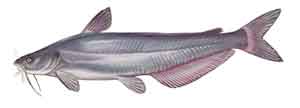 |
Photo
courtesy USFWS |
Blue Catfish (Ictalurus furcatus)
Other Names
Channel Cat, Hump-back Blue
Description
Ictalurus is Greek meaning "fish cat", and furcatus is
Latin, meaning "forked", a reference to the species' forked
tail fin. Blue catfish have a forked tail, and are sometimes very
similar to channel catfish. However, only the Rio Grande population
has dark spots on the back and sides. The number of rays in the
anal fin is typically 30-35, and coloration is usually slate blue
on the back, shading to white on the belly.
Life History
The spawning behavior of blue catfish appears to be similar to
that of channel catfish. However, most blue catfish are not sexually
mature until they reach about 24 inches in length. Like channel
catfish, the blue catfish pursues a varied diet, but it tends to
eat fish earlier in life. Although invertebrates still comprise
the major portion of the diet, blue catfish as small as four inches
in length have been known to consume fish. Individuals larger than
eight inches eat fish and large invertebrates. Blue catfish commonly
attain weights of 20 to 40 pounds, and may reach weights well in
excess of 100 pounds. It is reported that fish exceeding 350 pounds
were landed from the Mississippi River during the late 1800's.
Habitat
Blue catfish are primarily large-river fish, occurring in main
channels, tributaries, and impoundments of major river systems.
They tend to move upstream in the summer in search of cooler temperatures,
and downstream in the winter in order to find warmer water.
Distribution
Blue catfish are native to major rivers of the Ohio, Missouri,
and Mississippi river basins. The range also extends south through
Texas, Mexico, and into northern Guatemala. In Texas it is absent
from the northwestern portions of the state including the Panhandle,
but present elsewhere in larger rivers.
Other
The blue catfish is the largest freshwater sportfish in Texas.
Where mature populations exist, 50-pounders are not unusual. Typically,
the largest fish are caught by trotliners, some of whom have landed
specimens in excess of 115 pounds. The Texas rod-and-reel record
is 100 pounds. Catfish is the second most preferred group of fish
among licensed Texas anglers, and blues rank third behind channel
and flathead catfish. Like the channel cat, the blue catfish is
considered an excellent food fish.
|
 |
 |
 |
 |
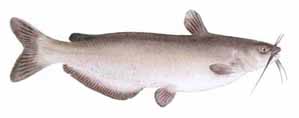 |
Illustration
© TPWD |
Channel Catfish (Ictalurus punctatus)
Other Names
Willow Cat, Forked-tail Cat, Fiddler, Spotted Cat, Lady Cat
Description
Ictalurus is Greek and punctatus is Latin, meaning "fish cat"
and "spotted", respectively. Channel catfish are easily
distinguished from all others, except blue catfish, by their deeply
forked tail fin. Unlike flathead catfish, the upper jaw projects
beyond the lower jaw. Coloration is olive-brown to slate-blue on
the back and sides, shading to silvery-white on the belly. Typically,
numerous small, black spots are present, but may be obscured in
large adults. The anal fin has 24-29 soft rays, in contrast to the
blue catfish which always has 30 or more rays in the anal fin.
Life History
Channel catfish spawn in late spring or early summer when water
temperatures reach 75°F. Males select nest sites which are normally
dark secluded areas such as cavities in drift piles, logs, undercut
banks, rocks, cans, etc. A golden-yellow gelatinous egg mass is
deposited in the bottom of the nest. Males guard the nest, and may
actually eat some of the eggs if they are disturbed. The eggs, if
not devoured, typically hatch in about a week. Fry remain in the
nest, under the guardianship of the male, for about another week.
In clear water, young fish appear to be much more susceptible to
predation and survival rates during the first year of life are much
lower. Channel catfish less than 4 inches in length feed primarily
on small insects. Adults are largely omnivorous, feeding on insects,
mollusks, crustaceans, fish, and even some plant material. Sexual
maturity is reached in two or three years in captivity, whereas
data from natural populations indicates channel catfish in Texas
reach sexual maturity in 3-6 years. Most are mature by the time
they reach 12 inches in length.
Habitat
Channel catfish are most abundant in large streams with low or moderate
current.
Distribution
Channel catfish are native to North America east of the Rockies
from southern Canada, south into northeastern Mexico, and east of
the Appalachians with the exception of much of the coastal plain
north of Florida. The species has been widely introduced in other
areas as far west as California. Today channel catfish range throughout
Texas, however, it is believed that the species was not native to
the upper Rio Grande and Pecos basins.
Other
Channel catfish ranks behind only bass and crappie as the most
preferred fish to catch in Texas. Popular with trotliners as well
as rod-and-reel anglers, channel cats may be captured on a wide
variety of baits including liver, worms, grasshoppers, shrimp, chicken,
cheese and stinkbait, among others. Undoubtedly, part of the reason
for their popularity is their delicious flavor when cooked. Channel
catfish in excess of 36 pounds have been landed in Texas waters.
The North American record stands at 58 pounds.
|
 |
 |
 |
 |
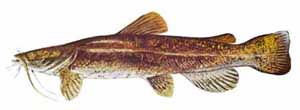 |
Photo
courtesy USFWS |
Flathead Catfish (Pylodictis olivaris)
Other Names
Yellow Cat, Opelousa Cat, Pied Cat, Mississippi Cat, Mud Cat, Shovelhead
Cat
Description
As the common name suggests, this catfish has a flat head, but
other than that, it looks like any other catfish: it has smooth,
scaleless skin, whisker-like barbels around the mouth, and long,
sharp spines on the dorsal (back) fin and one on each side of the
pectoral (shoulder) fin. Flathead catfish reach a length of 3 to
4 feet (0.9 to 1.2 m) and their weight can exceed 100 pounds (45
kg). Pylodictis is Greek meaning "mud fish", and olivaris
is Latin for "olive-colored". Flathead catfish are typically
pale yellow (hence the name "yellow cat") to light brown
on the back and sides, and highly mottled with black and/or brown.
The belly is usually pale yellow or cream colored. The head is broadly
flattened, with a projecting lower jaw. The tail fin is only slightly
notched, not deeply forked as is the case with blue and channel
catfish. Young fish may be very dark, almost black in appearance.
Life History
Unlike other catfish which are scavengers, flatheads prey only
on live fish. Young flathead catfish feed mostly on invertebrates
such as worms, insects and crayfish. When 10 inches or larger, their
diet consists entirely of fish-shad, carp, suckers, sunfish, largemouth
bass and other catfish (including their own kind). Flathead catfish
are eaten by alligators, water snakes, turtles, larger fish, and
humans. They reach sexual maturity between the third and sixth year.
Spawning season is from late May through August, when the water
temperature is between 75° and 80° F.
Males select hollow logs, caves or areas beneath the banks for
their nest sites. Males may even improve their selected sites by
creating shallow depressions for the females to lay their eggs.
Egg number varies greatly depending on female size, but the average
is up to 100,000 eggs at a time. Scientists estimate that a female
will lay 1200 eggs for every pound she weighs. A female flathead
that weights 50 pounds might release 60,000 eggs at a time. After
an incubation period of four to six days, the fry (very young fish)
will school together at the nest for several days after hatching;
afterwards they will seek shelter beneath rocks, roots and other
cover and begin their independent lives. Average lifespan of the
flathead catfish is 12 to 14 years, but one recorded flathead catfish
lived 24 years.
Adults are usually solitary, each staking out a favorite spot under
a tree or in a cove, in deep water. At night, they move into shallow
areas to feed. Males defend their nest and eggs aggressively. They
will fan the nest with their tails to keep the eggs clean and provide
them with oxygenated water. If females have been eating poorly,
their bodies may conserve resources by not releasing eggs. Poor
overall health and certain environmental conditions such as drought
or flood can reduce flatheads' ability to spawn. In healthy times,
clutches can reach 100,000 eggs, but only a small number will survive.
Habitat
Flathead catfish prefer deep pools of streams, rivers, canals,
lakes and reservoirs, where the water is turbid (cloudy) and the
currents are slow.
Distribution
Flathead catfish range from the lower Great Lakes through the Mississippi
River watershed to the Gulf states.
Other
In size, flatheads are the second largest sport fish in Texas after
their cousin, the blue catfish. Among those who selectively fish
for catfish, flatheads fall just behind channel catfish as a prized
species. Where mature populations exist, 50-pounders are not unusual.
Typically, the largest fish are caught by trotliners, who have landed
specimens in excess of 110 pounds. Rod and reel anglers may have
the greatest success with flathead catfish just below reservoir
dams. "Catfish" is the second most preferred group of
fish among licensed Texas anglers, and flatheads rank second behind
channel catfish. Because of their popularity with anglers, they
have been introduced in many other states where they have adapted
well. In some cases, however, they have out-competed the native
fish species, causing those native fish populations to decline sharply,
disrupting some natural ecological processes.
Catfish have long, sharp spines on the front edges of their dorsal
fins that are connected to venomous glands. Although the spines
can tear skin, the glands excrete venom. The venom is irritating
and some people have had serious problems with infection afterward.
(If you are "stung" by a catfish and are worried about
it, please call your doctor.).
|
 |
 |
 |
|
|
|



